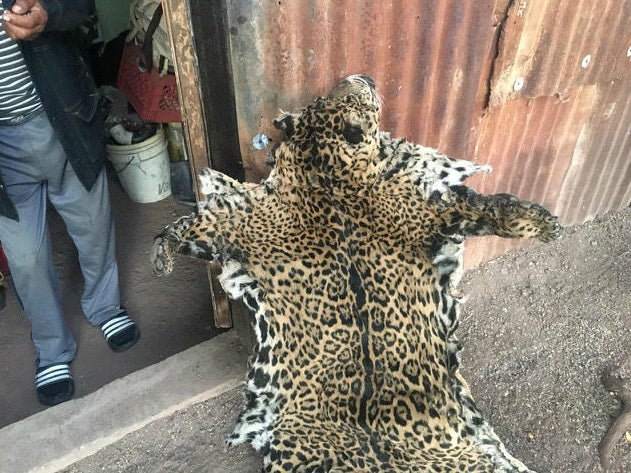One of two known jaguars living in US found dead
Killing the endangered big cats is illegal in America and Mexico

One of just two jaguars known to roam Arizona’s Huachuca Mountains is now believed dead after a photograph emerged of a jaguar pelt in Mexico.
The markings on the pelt reportedly match those of Yo’oko, a cat which had been photographed several times just north of the Mexican border in 2016 and early 2017. It was last photographed in March 2017.
The cat’s name was chosen by children at Tucson’s Hiaki High School and means “jaguar” in Yaqui – the language of the local tribe of the same name.
The cats are listed as an endangered species in both the US and Mexico and killing them is illegal.
The photograph of the pelt was released to the media by the Northern Jaguar Project, which operates a reserve in Sonora, 80 miles north of Tucson, and which aims to protect jaguars.
The group said they didn’t know when the photograph was taken nor who took it, but said it had been taken in Mexico.
The pattern of black markings on each jaguar is unique, enabling officials to identify specific individuals.
Jim DeVos, assistant wildlife management director for the Arizona Game and Fish Department in Phoenix told the Arizona Daily Star that six game and fish officials looked at the latest photo and compared it to an earlier photo of the Huachucas jaguar. They found “a very high correlation between the two pictures” based on spot patterns in the photos, he said.
“There’s not much more to say. We don’t know any of the specifics – where, when, how. We’re trying to get as much information as we can,” Mr DeVos added.
“This tragedy is piercing,” said Randy Serraglio of the Centre for Biological Diversity, which announced the news. “It highlights the urgency to protect jaguar habitat on both sides of the border and ensure that these rare, beautiful cats have safe places to live.”
“We must continue working to overcome the cultural prejudice that jaguars are somehow enemies of people,” said Mr Serraglio. “Indigenous people of the Americas have revered jaguars as majestic, powerful spirits of the wild for thousands of years. Whoever killed Yo’oko could learn a lot from them.”
He added: “The presence of jaguars in our mountains tells us that they are still whole and still wild. The thought of having to explain to those kids at Hiaki High School that somebody killed their favourite jaguar really just breaks my heart.”
Jaguars are the third-largest cats in the world after tigers and lions. Until the early 20th century they were common throughout the American Southwest, with their range extending as far north as the Grand Canyon and Colorado, as well as the mountains of Southern California and as far east as Louisiana.
The species has virtually disappeared from this part of their range over the past 150 years, due to habitat loss and historic US government predator control programs designed to protect livestock.
Jaguars continue to move into Arizona from Mexico, but Donald Trump’s plans to build a continuous border wall between the US and Mexico is considered a major threat to the return of a viable population in the US.
Seven jaguars have been confirmed by photographs in the United States over the past 20 years.
Carmina Gutierrez Gonzalez, a jaguar project biologist told the Arizona Star: “We’re very upset. It’s terrible. We’re very upset that somebody killed that jaguar. I just can’t believe that. It’s really sad for us.”
Join our commenting forum
Join thought-provoking conversations, follow other Independent readers and see their replies
Comments